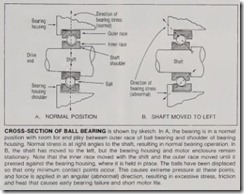Making motors last longer
By JOSEPH SMITH
MOTORS LAST LONGER and run bette r when all m echanical components fit together properly. According to Joseph Smith, general manager, R. Schei n ert & Son, Philadelphia, PA, most motor failures are the result of mechanical malfunction. Most mechan ical malfunctions relate to the motor beari n gs, bearing housings, shaft and end bells. Because of this, the firm
provides special attention to these com ponents and suggests that plant oper ating and maintenance personnel in spect and maintain these parts on a regular basis.
When a motor comes in for repair or rebuild, Scheinert technicians carefully inspect bearings and housings for dirt or contamination, damage, dents, scratches, out-of-round balls or races, or distortion of any kind. They also check the shaft and end bells for wear or damage. If the shaft is worn or damaged in any way, it receives flame spray metallizing and is turned down back to original specifications.
After repair to the motor is com pleted-rewind or reconditioning-all components are checked for proper size and fit. Measurements must be accu rate. Tolerances must permit all com ponents to expand during operation of the motor and yet maintain proper “freewheeling” with no binding that could cause overheating and eventual failure.
Next, the motor is reassembled and rotation is checked for freedom. Also, as shown in the accompanying photo, end play of the rotor/shaft is carefully checked. The technician in the photo is measuring the amount of end play with a dial indicator mounted on the end bell. The amount of movement should match the manufacturer’s specifications. Smith points out that the proper amount of end play is critical, because as the shaft expands during operation of the motor, enough room must be available to avoid binding of any sort that would shorten bearing life. All motors will have some amount of end play in the range of lj32 in. to 1/ts in. Some designs however, have a locked bearing at one end, which results in the rotor not moving in an axial direction. Therefore the opposing bearing must be able to move or “float” to provide the required freedom. This type should be checked only by experienced person nel.
Primary causes of excessive, damag ing end play include worn bearings or bearing housing, a worn or bent shaft, or contamination that could cause binding, wear and then excessive end play-in that order.
Usually, excessive end play is hard to detect during normal operation and inspection unless it is extreme. If it is suspected, it is best to call in a motor repair expert, because a thorough anal
ysis of the problem should be per formed.

